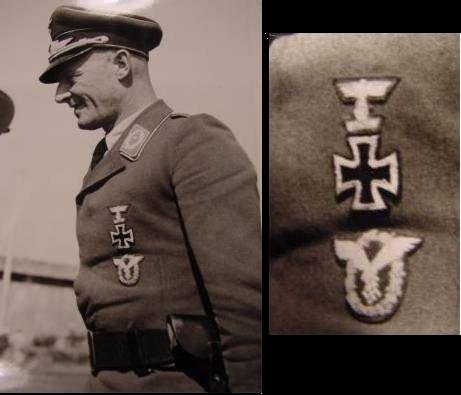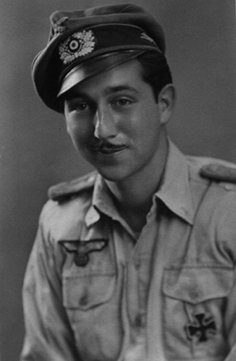
by Sebastián J. Bianchi

The Iron Cross 1st Class had the same dimensions and identical obverse features as the 2nd Class (44mm by 44mm). Constructed of 3 pieces, the 1st class was a breast badge and therefore the reverse was a solid silvered metal plate with only the attachment mechanism present. For manufacturing process, please see the section in this article bearing that name.
The fastening mode could consist of either a hinged pin and catch, or the privately purchased screw-back system (discussed below in "Variations"). Several styles of the pin and catch attachment existed; one finds "fat bellied" pins, straight pins, and tapered pins. The pin-and-catch mechanism can very often reveal clues as to who manufactured an unmarked cross. Period pins and the catches (which almost always consisted of a classic "c" catch) were sturdy and do not yield to finger pressure.
While most of the Iron Crosses are "flat", some have a slightly convex appearance.
The 1st Class of the Iron Cross was presented more scarcely, and logically held a correspondingly higher level of stature than the second class. In order to receive the Iron Cross 1st Class Heer and Waffen SS men would have to perform three to four further acts of courage from the one that earned him the 2nd Class. The Luftwaffe and Kriegsmarine had the following criteria; the award was regularly awarded to U-boat Commanders upon sinking 50,000 tons and to Luftwaffe pilots when they achieved six or seven confirmed kills. Of course these were only guidelines, and a single act of great importance or a long steady career could earn the individual the Cross.
Click on images to enlarge
| This
"Divisionstagesbefehl" shows 42 soldiers from the 263
I.D. who received the Iron Cross 1st class on 25.1.1944. Signed
by Gen.Lt. Werner Richter, D.K.i.G. on 26.Nov.1943 - R.K. on
7.Feb.1944.
Chris Varveris Collection |
 |
 |
| Iron Cross 1st Class wear | |
Manufactures
If present the manufacturer's mark is found on either side of the pin, or on the reverse of the cross either at the lower arm or the center. As in the case of the 2nd Class, unmarked crosses are perfectly normal if a little less desired by the average collector.
Below is a database of known makers with photographs. Click on the maker to see photos.
| FIRM # | FIRM | LOCATION |
|---|---|---|
| 1 | Deschler & Sohn | Munchen |
| 2 | C.E. Juncker | Berlin |
| 3 | Wilhelm Deumer | Lüdensched |
| 4 | Steinhauer & Lück | Lüdensched |
| 6 | Fritz Zimmermann | Stuttgart |
| 7 | Paul Meyhauer | Berlin |
| 8 | Ferdinand Hoffstadter | |
| 11 | Grossmann & Co. | Wien |
| 15 | Friedrich Orth | Wien |
| 20 | C.F. Zimmermann | Pforzheim |
| 25 | Arbeitsgemeinschaft der Graveur-Gold-und Silberschemiede-Innungen | |
| 26 | B. H. Mayer's Kunst-prageanstalt | Pforzheim |
| 52 | Gottlieb & Wagner | Ldar/Oberstein |
| 65 | Klein & Quenzer A.G. | Idar/Oberstein |
| 100 | Rudolf Wachtler & Lange | Mittweida |
| 107 | Carl Wild | Hamburg |
| L/10 | Deschler & Sohn | Munchen 9 Wirthstrasse 9 |
| L/11 | Wilhelm Deumer | Lüdensched, Postfach 161 |
| L/12 | C.E. Junker | Berlin SW 68, Alte Jakobstr. 13 |
| L/13 | Paul Meybauer | Berlin SW 68, Alte Jakobstr. 13 |
| L/15 | Otto Schickle | Pforzheim |
| L/16 | Steinhauer & Lück | Lüdensched |
| L/18 | D.H. Mayer's, Hofkunstprageanstalt | Pforzheim |
| L/19 | Ferkinand Hoffstatter | Bonn/Rhein Postfach 161 |
| L/50 | Gebr. Godet & Co. | Berlin W8 Jagerstr. 19 |
| L/52 | C.F. Zimmermann | Pforzheim |
| L/53 | Hymmen & Co. | Lüdensched Karlstr. |
| L/54 | Schauerte & Hohfeld | Lüdensched |
| L/55 | Wachtler & Lange Rudolf | Mittwaida/Sa. |
| L/56 | Funcke & Bruninghaus | |
| L/57 | Boerger & Co. | Berlin SO 16 Adalbertstr. 42 |
| L/58 | Rudolf Souval | |
| L/59 | Alois Rettenmaier | Schwabisch-Gmund Parlerstr. 27 |
Variations
Screw-back Iron Cross
The "screw-back" types, more scarcely found and thus worth more to the collector, had a protruding threaded shaft that was placed through the tunic. It was held by a round plate that screwed on from behind. Sometimes, a small pin on the reverse of the upper arm was added to keep the Cross from rotating on its axis.

Reverse of a screw-back variation
Click on images to enlarge
| This type of cross
would have been available for private purchase. Retail outlet was under the control of the LDO,
and screw-backs this type of cross were
specifically approved in 1941. They had been
previously made, and so they were essentially available
throughout the war.
Courtesy Gordon Williamson |
Below are some makers that have manufactured this variation,
Double Maker Marked
In the case of two makers, C.F. Zimmermann and Steinhauer & Luck , it is possible to find examples with Prasidialkanzlei and LDO markings on them.

Click on images to enlarge
No Iron, Iron Cross?
This variation of the Iron Cross has its core made from non-magnetic materials, usually brass but also possibly zinc. As with the Second Class, there are estimated to be early production pieces.
Click on image to enlarge
Shinkelform Iron Cross
The Shinkelform cross is a rare variation of this class. Like the 2nd class, these were made from the 1914 dies and thus have narrower features, as pictured below.
Click on image to enlarge
Round 3
The obverse of this variation is identical to the one described in the 2nd class. These crosses are also rather scarce.
Click on image to enlarge
Cloth
Iron Crosses 1st Class made of cloth did exist during the Third Reich, but they post an extremely difficult challenge to the modern day collector as their authentication is very difficult. Add the fact that you have an abundance of fakes manufactured over the decades, and the challenge is even tougher.

Rare picture (courtesy William Stump) which shows the cloth cross in wear. |
|
Leutnant Bernd Heukemes, Panzergrenadier in the 116th Panzer Division "Windhund" wears an Iron Cross 1st Class in cloth (courtesy Frank H.) |
Foreign Made Iron Cross
Both Japan and Spain produced Iron Crosses. Japan did so for German sailors stationed in Tokyo, and these are very rare crosses. .

Germany decorated deserving members of the Spanish Blue Division and the Blue Legion with Iron Crosses. As the swastika was not outlawed in Spain after World War II, Spanish mints continued to produce the crosses unabated for both veteran and collector alike. The Spanish variation vary from well made to very low quality, but can usually be differentiated from it's German counterpart without too great difficulty.
Click on images to enlarge
Between 300,000 and 575,000 Iron Cross 1st Class were awarded during World War II.
![]()
© Copyright Wehrmacht-Awards.com LLC |















